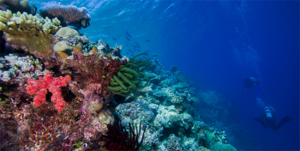
Nowhere today is the biodiversity of corals and reef-inhabiting fish higher than in the tropical waters around Indonesia and its neighbouring countries in Southeast Asia. “To understand the reason for this diversity, you have to look back 100 million years — to a time when present-day South America and Africa still formed a common supercontinent and today’s India was an island in Earth’s southern hemisphere,” says Loïc Pellissier, Professor of Landscape Ecology at ETH Zurich and the Swiss Federal Institute for Forest, Snow and Landscape Research WSL and, up until ten months ago, Lecturer at the University of Fribourg.
For the first time ever, an international research team under his direction studied the geographical pattern by which new species of corals and reef fish evolved over the millions of years of evolutionary history using a computer model. The scientists were able to show that the drift of the continental plates was the likely driving force behind the emergence of new species.
Combination of different models
To arrive at this conclusion, the researchers combined different simulations and data. These included a simulation of geological changes to the seafloor during Earth history as well as information on the earlier expansion of the tropics based on fossil finds of tropical coral species. Thus, the scientists were able to create a dynamic spatial model that indicates where throughout the course of history shallow and warm waters were located, in which corals and other tropical organisms found a habitat.
Into this model, they integrated a well-known evolution mechanism in which two new species are formed out of an existing one. By way of illustration, take any fish species that lived in a tropical reef ecosystem 100 million years ago. If its home reef is divided into two separate reefs due to plate tectonics, for example, the two populations in each patch would continue to evolve independently and eventually, over the following hundreds of thousands of years, become two distinct species.
Hotspot in the prehistoric ocean
Such a fragmentation of tropical reef habitats actually took place, as Pellissier and his colleagues showed in their model calculations. Their simulation begins 140 million years ago, when present-day South America, Africa, India and Australia together formed the supercontinent Gondwana. A huge, contiguous body of shallow water ran along its equatorial coasts. In the millions of years to follow, the supercontinent broke up; there were massive continental drifts and fragmentation of the tropical reefs.
A particularly strong fragmentation took place about 50 to 60 million years ago, as Fabien Leprieur, Professor at the University of Montpellier and the study’s first author, explains: “At that time in the western part of Tethys, the prehistoric ocean between Africa and Eurasia, there was a complex seafloor structure with many disconnected reefs — a bona fide patchwork.” The plate tectonic processes at that time separated and merged these waters. It was an extremely dynamic system that strongly favoured the emergence of new species.
It was known from fossil finds that the Western Tethys region was a hotspot of species development back then. Fossil finds have also shown that this hotspot has shifted in the past 60 million years, from the Tethys to today’s Southeast Asia. “Now, for the first time, our models provide an explanation for this movement,” says Pellissier. “Because of the plate tectonic processes, new habitats emerged in different locations over the course of millions of years, while others merged or disappeared. These dynamic structures encouraged the relocation of the focal point of species diversity,” says the landscape ecology professor.
Unification of Australian and Asian fauna
However, today’s biodiversity in Southeast Asia cannot be explained solely by this relocation; rather, this was the region where, around 15 million years ago, the marine fauna of Tethys came together with that of Australia. This encounter was also the result of continental drift, in this case the shifting of the Australian continental plate in the direction of the equator, as Pellissier and his colleagues illustrate. “It was already known that this Australasian encounter took place with terrestrial animals and plants. We’ve now shown that it happened with tropical marine life too.”
Coral reef ecosystems, which are the focus of this study, are sensitive to changes in temperature and are in danger worldwide due to global warming: the Great Barrier Reef in Australia is currently experiencing the largest coral bleaching in its history. Pellissier says: “In this context, it’s important to understand that today’s reef ecosystems have a very long history. It took 100 million years to build this extraordinarily large biodiversity, but it might take less than 100 years to destroy it.”
Video
Reference:
Fabien Leprieur, Patrice Descombes, Théo Gaboriau, Peter F. Cowman, Valeriano Parravicini, Michel Kulbicki, Carlos J. Melián, Charles N. de Santana, Christian Heine, David Mouillot, David R. Bellwood, Loïc Pellissier. Plate tectonics drive tropical reef biodiversity dynamics. Nature Communications, 2016; 7: 11461 DOI: 10.1038/ncomms11461
Note: The above post is reprinted from materials provided by ETH Zurich. The original item was written by Fabio Bergamin.










